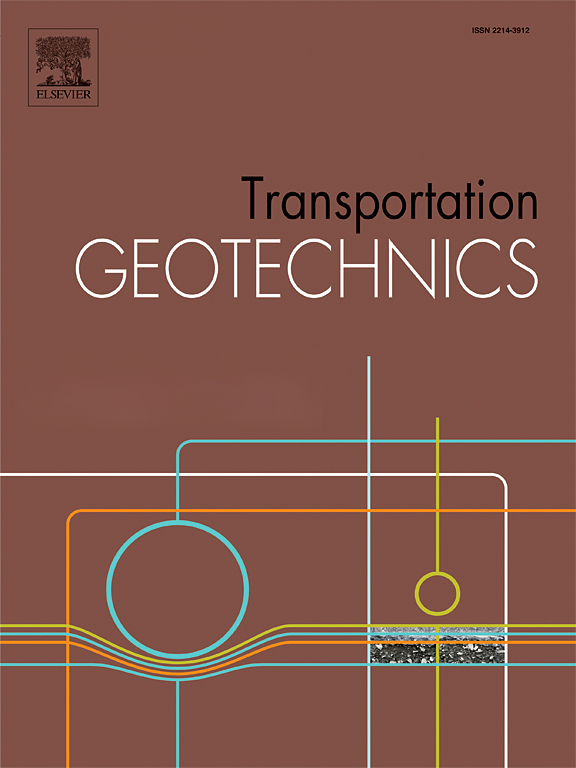考虑隧道底板隆起的双块式无砟轨道损伤特征及接触界面演变行为研究
IF 4.9
2区 工程技术
Q1 ENGINEERING, CIVIL
引用次数: 0
摘要
铁路隧道底面隆起(TFH)过大会降低轨道结构的耐久性,危及列车运行安全。根据监测数据,将 TFH 特性拟合成余弦曲线和双正弦曲线。建立了 TFH 下双块式无砟轨道的非线性失效分析模型。探讨了不同 TFH 特性下轨道结构的变形传递规律、结构损伤机理和层间粘结界面失效演化过程。结果表明,TFH 的变形可以很好地映射到履带上。振幅传递比小于 100%。余弦和双线性 TFH 下的最大波长传递比分别为 129.3 % 和 127.5 %。为避免轨道结构受损,当波长为 10 m 时,余弦和双线性 TFH 的振幅应分别控制在 2.5 mm 和 0.5 mm。当波长大于 10 米时,可适当增大振幅。为避免层间粘结开裂,波长为 10 m 的余弦振幅和双线性振幅应分别控制在 5 mm 和 1.5 mm。余弦曲线下的轨道-隧道层间脱粘故障发生在 TFH 边缘,而双线曲线下的脱粘故障发生在 TFH 中心和边缘。余弦和双线性 TFH 下的间隙分别呈现双峰和多峰形状。该研究可为控制 TFH 引起的轨道结构性能下降提供理论指导。本文章由计算机程序翻译,如有差异,请以英文原文为准。
Research on damage characteristics and contact interface evolution behavior of double-block ballastless track considering tunnel floor heave
Excessive railway tunnel floor heave (TFH) will reduce the durability of the track structure and jeopardize train operation safety. The TFH characteristics were fitted into cosine and bilinear curves according to the monitoring data. A nonlinear failure analysis model of double-block ballastless track under TFH was established. The deformation transfer law, structural damage mechanism and the interlayer bonding interface failure evolution of the track structure under different TFH characteristics were explored. The results show that the deformation of TFH can be well mapped to the track. The amplitude transfer ratio is less than 100 %. The maximum wavelength transfer ratio under the cosine and bilinear TFH is 129.3 % and 127.5 %, respectively. To avoid the damage of track structure, when the wavelength is 10 m, the amplitude of cosine and bilinear TFH should be controlled at 2.5 mm and 0.5 mm respectively. When the wavelength is greater than 10 m, the amplitude can be appropriately increased. To avoid interlayer bonding cracking, the cosine and bilinear amplitudes with a wavelength of 10 m should be controlled at 5 mm and 1.5 mm, respectively. The track-tunnel interlayer debonding failure under the cosine curve occurs at the edge of the TFH, while the bilinear curve occurs at the center and edge of the TFH. The gaps under the cosine and bilinear TFH exhibit double-peak and multi-peak shapes, respectively. This study can provide theoretical guidance for controlling the performance degradation of track structure caused by TFH.
求助全文
通过发布文献求助,成功后即可免费获取论文全文。
去求助
来源期刊

Transportation Geotechnics
Social Sciences-Transportation
CiteScore
8.10
自引率
11.30%
发文量
194
审稿时长
51 days
期刊介绍:
Transportation Geotechnics is a journal dedicated to publishing high-quality, theoretical, and applied papers that cover all facets of geotechnics for transportation infrastructure such as roads, highways, railways, underground railways, airfields, and waterways. The journal places a special emphasis on case studies that present original work relevant to the sustainable construction of transportation infrastructure. The scope of topics it addresses includes the geotechnical properties of geomaterials for sustainable and rational design and construction, the behavior of compacted and stabilized geomaterials, the use of geosynthetics and reinforcement in constructed layers and interlayers, ground improvement and slope stability for transportation infrastructures, compaction technology and management, maintenance technology, the impact of climate, embankments for highways and high-speed trains, transition zones, dredging, underwater geotechnics for infrastructure purposes, and the modeling of multi-layered structures and supporting ground under dynamic and repeated loads.
 求助内容:
求助内容: 应助结果提醒方式:
应助结果提醒方式:


